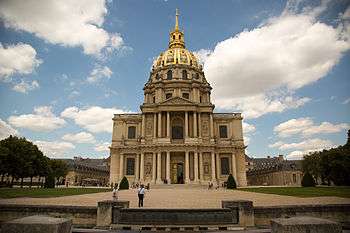Les Invalides
| Hôtel des Invalides | |
|---|---|
|
Hôtel des Invalides | |
 Location within Paris | |
| Alternative names | Les Invalides, Musée de l'Armée |
| General information | |
| Type | Museum, Church, Hospital, Retirement home, Mausoleum |
| Architectural style | Baroque |
| Location | Paris, France |
| Coordinates | 48°51′18″N 2°18′45″E / 48.85500°N 2.31250°ECoordinates: 48°51′18″N 2°18′45″E / 48.85500°N 2.31250°E |
| Construction started | 1671 |
| Inaugurated | 1678 |
| Design and construction | |
| Architect | Libéral Bruant, Jules Hardouin Mansart |
| Website | |
|
www | |
Les Invalides (French pronunciation: [lezɛ̃valid]), commonly known as Hôtel national des Invalides (The National Residence of the Invalids), or also as Hôtel des Invalides, is a complex of buildings in the 7th arrondissement of Paris, France, containing museums and monuments, all relating to the military history of France, as well as a hospital and a retirement home for war veterans, the building's original purpose. The buildings house the Musée de l'Armée, the military museum of the Army of France, the Musée des Plans-Reliefs, and the Musée d'Histoire Contemporaine, as well as the Dôme des Invalides, a large church with the burial site for some of France's war heroes, most notably Napoleon Bonaparte (lists below).
History
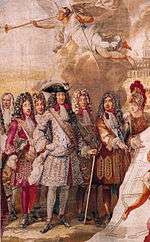
Louis XIV initiated the project by an order dated 24 November 1670, as a home and hospital for aged and unwell soldiers: the name is a shortened form of hôpital des invalides.[1] The architect of Les Invalides was Libéral Bruant. The selected site was in the then suburban plain of Grenelle (plaine de Grenelle). By the time the enlarged project was completed in 1676, the river front measured 196 meters and the complex had fifteen courtyards, the largest being the cour d'honneur ("court of honour") for military parades. It was then felt that the veterans required a chapel. Jules Hardouin Mansart assisted the aged Bruant, and the chapel was finished in 1679 to Bruant's designs after the elder architect's death. This chapel was known as Église Saint-Louis des Invalides, and daily attendance of the veterans in the church services was required.
Shortly after the veterans' chapel was completed, Louis XIV commissioned Mansart to construct a separate private royal chapel referred to as the Église du Dôme from its most striking feature (see below). The domed chapel was finished in 1708.
Later history

Because of its location and significance, the Invalides served as the scene for several key events in French history. On 14 July 1789 it was stormed by Parisian rioters who seized the cannons and muskets stored in its cellars to use against the Bastille later the same day. Napoleon was entombed under the dome of the Invalides with great ceremony in 1840. In December 1894 the degradation of Captain Alfred Dreyfus was held before the main building, while his subsequent rehabilitation ceremony took place in a courtyard of the complex in 1906.
The building retained its primary function of a retirement home and hospital for military veterans (invalides) until the early twentieth century. In 1872 the musée d'artillerie (Artillery Museum) was located within the building to be joined by the musée historique des armées (Historical Museum of the Armies) in 1896. The two institutions were merged to form the present musée de l'armée in 1905. At the same time the veterans in residence were dispersed to smaller centres outside Paris. The reason was that the adoption of a mainly conscript army, after 1872, meant a substantial reduction in the numbers of veterans having the twenty or more years of military service formerly required to enter the Hôpital des Invalides. The building accordingly became too large for its original purpose. The modern complex does however still include the facilities detailed below for about a hundred elderly or incapacitated former soldiers.
Architecture
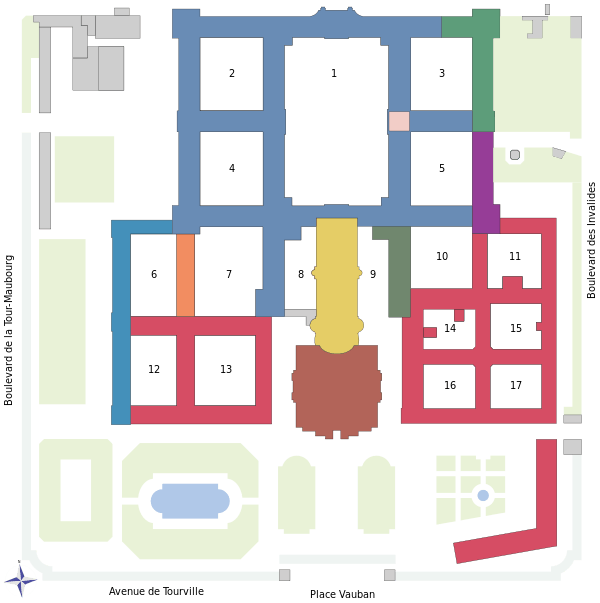 | |
|
Dome of Les Invalides
Saint-Louis-des-Invalides Cathedral
Musée de l'Ordre de la Libération |
Institution nationale des Invalides
Gouverneur des Invalides
Gouverneur militaire de Paris
Chancellerie de l'Ordre de la Libération
Office national des anciens combattants et victimes de guerre |
|
|

On the north front of Les Invalides (illustration, right) Hardouin-Mansart's chapel dome is large enough to dominate the long façade, yet harmonizes with Bruant's door under an arched pediment. To the north, the courtyard (cour d'honneur) is extended by a wide public esplanade (Esplanade des Invalides) where the embassies of Austria and Finland are neighbors of the French Ministry of Foreign Affairs, all forming one of the grand open spaces in the heart of Paris. At its far end, the Pont Alexandre III links this grand urbanistic axis with the Petit Palais and the Grand Palais. The Pont des Invalides is next, downstream the Seine river. The Hôpital des Invalides spurred William III of England to emulation, in the military Greenwich Hospital of 1694.
The buildings still comprise the Institution Nationale des Invalides,[2] a national institution for disabled war veterans. The institution comprises:
- a retirement home
- a medical and surgical centre
- a centre for external medical consultations.
Gallery
-
Visit of Louis XIV to Les Invalides. Painting by Pierre-Denis Martin
-

Jardin des Invalides
-

Aerial view of Les Invalides
-
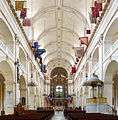
According to an old tradition, war trophies decorate the vault of the chapel of Saint-Louis-des-Invalides.
-
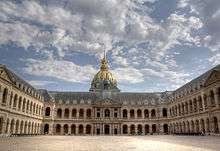
Court of the museum of the Army
-

The Qianlong Emperor's military costume at the Musée de l'Armée.
-

Les Invalides at night.
-

Dome of Les Invalides.
Churches at Les Invalides
In 1676 Jules Hardouin-Mansart was commissioned with the construction of a place of worship on the site. He designed a building which combined a royal chapel (now Dôme des Invalides) with a veterans' chapel (now Cathedral of Saint-Louis des Invalides). In this way, the King and his soldiers could attend mass simultaneously, while entering the place of worship though different entrances, as prescribed by court etiquette. This separation was reinforced in the 19th century with the erection of the tomb of Napoleon I, the creation of the two separate altars and then with the construction of a glass wall between the two chapels.
The Cathedral of Saint-Louis des Invalides
When the Army Museum at Les Invalides was founded in 1905, the veterans' chapel was placed under its administrative control. It is now the cathedral of the Diocese of the French Armed Forces, officially known as Cathédrale Saint-Louis-des-Invalides.[3]
Dôme des Invalides
The Dôme des Invalides (originally Chapelle royale des Invalides) is a large former church in the centre of the Les Invalides complex.
The dôme was designated to become Napoleon's funeral place in a law dated 10 June 1840. The excavation and erection of the crypt, that heavily modified the interior of the domed church, took twenty years to complete and was finished in 1861.[4][5]
Inspired by St. Peter's Basilica in Rome, the original for all Baroque domes, the Dôme des Invalides is one of the triumphs of French Baroque architecture. Mansart raised its drum with an attic storey over its main cornice, and employed the paired columns motif in his more complicated rhythmic theme. The general programme is sculptural but tightly integrated, rich but balanced, consistently carried through, capping its vertical thrust firmly with a ribbed and hemispherical dome. The domed chapel is centrally placed to dominate the court of honour.
The interior of the dome (107 meter of height; see gallery) was painted by Le Brun's disciple Charles de La Fosse with a Baroque illusion of space (sotto in su) seen from below. The painting was completed in 1705.
Tombs and vaults
Tombs


The most notable tomb at Les Invalides is that of Napoleon Bonaparte (1769–1821). Napoleon was initially interred on Saint Helena, but King Louis-Philippe arranged for his remains to be brought to France in 1840, an event known as le retour des cendres. Napoléon's remains were first buried in the Chapelle Saint-Jérôme in the Invalides until his final resting place, a tomb made of red quartzite and resting on a green granite base, was finished in 1861.
Some members of Napoleon's family, several military officers who served under him, and other French military heroes are also buried at Les Invalides:
- Henri Gratien, Comte Bertrand (1773–1844), army general during the First French Empire who accompanied Napoleon to Elba and then St Helena. He brought Napoleon's body back to France in 1840.
- Joseph Bonaparte (1768–1844), Napoleon's elder brother.
- Jérôme Bonaparte (1784–1860), Napoleon's youngest brother.
- Napoleon II (1811–1832) son of Napoleon. his heart and intestines remained in Vienna
- Thomas Bugeaud (1784–1849), Marshal of France and conqueror of Algeria.
- François Canrobert (1809–1895), Marshal of France.
- Geraud Duroc (1774–1813), general who fought with Napoleon.
- Claude Joseph Rouget de Lisle (1760–1836), army captain, author of France's national anthem, La Marseillaise.
- Ferdinand Foch (1851–1929), Marshal of France, Allied Supreme Commander in the First World War.
- Henri de la Tour d'Auvergne, Vicomte de Turenne (1611–1675), better known as Turenne, Marshal General of France under Louis XIV and one of France's greatest military leaders.
- Sébastien Le Prestre de Vauban's heart (1633–1707), designer of Louis XIV's military fortifications.
- Pierre Auguste Roques (1856–1920), founder of the French Air Force and Minister of War in 1916.
- Philippe Leclerc de Hauteclocque (1902–1947), Marshal of France, hero of World War II, commander of the famous 2nd Armored Division.
- Jean de Lattre de Tassigny (1889–1952), Marshal of France, commander of the French First Army during World War II and later commander in the First Indochina War.
Vaults

The bodies of the following are interred in the vaults of Les Invalides[6] (see images: 1, 2, 3, 4):
- Marshal Lyautey
- General Robert Nivelle
- General Charles Mangin
- Marshal de Mac-Mahon
- Marshal Leclerc de Hauteclocque
- 14 victims of the attack of Fieschi of July 28, 1835
- Marshal General Turenne (1800)
- General Lasalle (1809)
- General Lariboisière (1812)
- Marshal Bessières (1813)
- Marshal Jourdan (1833)
- Marshal Lobau (1839)
- General Bertrand (1844)
- Marshal Valée (1846)
- Admiral Duperré (1847)
- General Duroc (1847)
- Marshal Sérurier (1847)
- General Duvivier 1848
- Marshal Bugeaud (1849)
- Marshal Sébastiani (1851)
- Marshal Exelmans (1852)
- Marshal Saint-Arnaud 1854
- Admiral Hamelin (1864)
- Marshal Pélissier, duke de Malakoff (1864)
- Marshal Regnaud de Saint-Jean d'Angély (1870)
- Marshal Baraguay d'Hilliers 1878
- Marshal Canrobert 1895
- General Paul Edouard Arnoux, Commandant des Invalides (1891–1902)
- General Lasalle (1897)
- Claude Joseph Rouget de Lisle, composer of La Marseillaise (1915)
- General Roques (1920)
- General Louis de Maud'huy 1921
- General Humbert 1921
- General Maistre 1922
- Marshal Maunoury (1923)
- General Malleterre 1923
- General de Mitry 1924
- Admiral Boué de Lapeyrère (1852–1924)
- General Lanrezac (1925)
- General Putz 1925
- General Baucheron de Boissoudy (1926)
- General Gerard (1926)
- General Ruffey 1926
- General de Langle de Cary 1927
- Marshal Fayolle (1928)
- General Sarrail (1929)
- Vice-admiral Gauchet (1931)
- General Pau 1932
- Vice-admiral Fournier 1934
- General Cordonnier 1936
- Admiral Guépratte 1939
- Admiral Ronarc'h 1940
- General Guillaumat 1940
- General d'Amade 1941
- General d'Urbal 1943
- Marshal Franchet d' Esperey (1942)
- General Henrys 1944
- Marshal Leclerc de Hauteclocque 1947
- General Henri Giraud 1949
- General Duchêne 1950
- General Houdémon 1959
- General Kientz 1962
- General Monclar (1964)
- Marshal Juin (1967)
The hearts of the following are interred in the vaults of Les Invalides while their bodies rest elsewhere:
- Jean Beryrand, lord of Senneric 1691
- General Jean Baptiste Kléber
- General Jean-Joseph Ange d'Hautpoul 1807
- Major general de Bisson 1811
- Major general Jean Baptiste Eblé (1813)
- Lieutenant general Baraguey d'Hilliers (1813)
- Marie Maurille de Sombreuil, countess of Villelume (1823)
- Lieutenant-general de Conchy (1823)
- Major general Négrier 1848
Influence
- San Francisco City Hall Built in 1914-1915.
- The United States Naval Academy Chapel in Annapolis, Maryland USA, built 1904-1908, architect Ernest Flagg. The chapel was enlarged in 1940, changing it from a Greek cross to a Roman cross. The new section was designed by Philadelphia architect Paul Cret. John Paul Jones is buried in the crypt in a sarcophagus made of marble from the Pyrenees donated by the people of France.
- Panteón de los Héroes built in 1864 and finished in 1936. Cultural Patrimony of Asunción,[7] it's an oratory of the Assumption of Mary and inside it rest some of the greatest heroes of Paraguay like Francisco Solano López, José Félix Estigarribia and others. Designed by the Italian architect Alessandro Ravizza.
See also
- List of museums in Paris
- List of hospitals in France
- List of tallest structures in Paris
- Military history of France
- San Francisco City Hall, the design of which was influenced by Les Invalides
- La Tour-Maubourg, adjacent Paris Metro stop convenient to Les Invalides
- National Pantheon of Venezuela
- Buenos Aires Metropolitan Cathedral
- National Pantheon of the Heroes
- Altar de la Patria
- Artigas Mausoleum
- West Virginia State Capitol
- List of works by James Pradier
References
- ↑ The Paris Army Museum - Hôtel des Invalides
- ↑ http://homepage.mac.com/fnpgig/institutionnationaleinvalides.html
- ↑ Cathedral of Saint-Louis des Invalides (online), accessed 16 October 2015
- ↑ Dôme des Invalides, tomb of Napoleon I, accessed 18 October 2015
- ↑ Musée de l’Armée Invalides - Brochure, accessed 18 October 2015
- ↑ Eglise Saint-Louis des Invalides: Le tombeau des Gouverneurs (online), accessed 16 October 2015
- ↑
External links
| Wikimedia Commons has media related to Les Invalides. |
|
